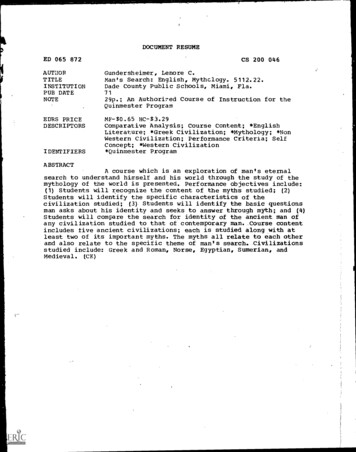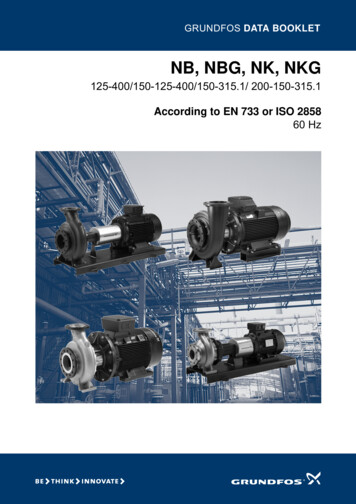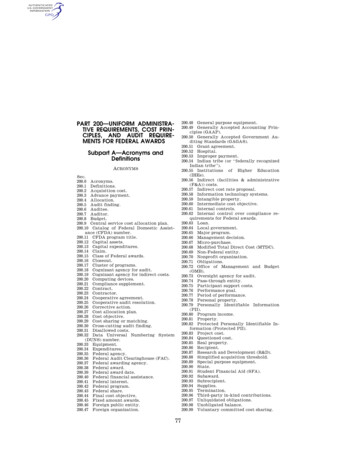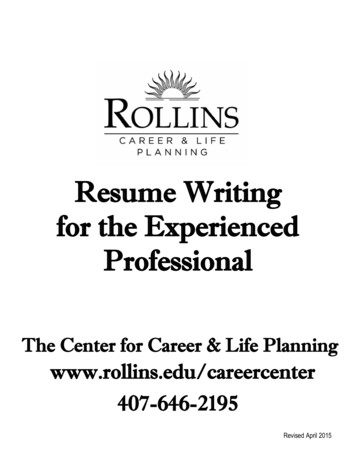
Transcription
DOCUMENT RESUMEED 065 872CS 200 046AUTHORTITLEINSTITUTIONPUB DATENOTEGundersheimer, Lenore C.Man's Search: English, Mythclogy. 5112.22.Dade County Public Schools, Miami, Fla.EDRS PRICEDESCRIPTORSMF- 0.65 HC- 3.29Comparative Analysis; Course Content; *EnglishLiterature; *Greek Civilization; *Mythology; *NonWestern Civilization; Performance Criteria; SelfConcept; *Western Civilization*Quinmester ProgramIDENTIFIERS7129p.; An Authori7ed Course of Instruction for theQuinmester ProgramABSTRACTA course which is an exploration of man's eternalsearch to understand hirself and his world through the study of themythology of the world is presented. Performance objectives include:(1) Students will recognize the content of the myths studied; (2)Students will identify the specific characteristics of thecivilization studied; (3) Students will identify the basic questionsman asks about his identity and seeks to answer through myth; and (4)Students will compare the search for identity of the ancient man ofany civilization studied to that of contemporary man.Course contentincludes five ancient civilizations; each is studied along with atleast two of its important myths. The myths all relate to each otherand also relate to the specific theme of man's search. Civilizationsstudied include: Greek and Roman, Norse, Egyptian, Sumerian, andMedieval. (Cu)r.
FILMED FROM BEST AVAILABLE COPYAUTHORIZED COURSE OF INSTRUCTION FOR THE1: c'DLanguage Arts: 16.225188.02rc-)te)c",et")DIVISION OF INSTRUCTION1971
U.S. OEPARTMENT OF HEALTH, EOUCATIONi& WELFAREOFFICE OF EDUCATIONTHIS DOCUMENT HAS BEEN REPRODUCEDEXACTLY AS RECEIVED FROM THE PERSON ORORGANIZATION ORIGINATING IT POINTS OFVIEW OR OPINIONS STATEO DO NOT NCCESSARILY REPRESENT OFFICIAL OFFICE OF EDUCATIO,. POSITION OR POLICYMAN'S glish, MythologyPitten by Lenore C. Gundersheimerfor theDrVISION OF INSIMICTIONDade County Public SchoolsMiami, Florida19710-PERMISSION TO REPRODUCE THIS COPYRIGHTED MATERIAL HAS BEEN GRANTEDBYDade CountyPublic SchoolsTO ERIC ANO ORGANIZATIONS OPERATINGUNDER AGREEMENTS WITH THE U.S. OFFICEOF EDUCATION. FURTHER REPRODUCTIONOUTSIOE THE ERIC SYSTEM REQUIRES PERMISSION OF THE COPYRIGHT OWNER
DADE COUNTY SCHOOL BOARDMr. William Lehman, ChairmanMr. G. Holmes Braddock, Vice-ChairmanMrs. Ethal BeckhamMrs. Crutcher HarrisonMrs. Anna Brenner MeyersDr. Ben SheppardMr. William H. TurnerDr. E. L. Whigham, Superintendent of SchoolsDade County Public Sc:.,olsMiami, Florida 33132Published by the Dade County School Board
CDUPSE TITLE:CourseNumberMAN'S SEARCHCOURSE DESCRIPTION: Tv- t-!:.,:plorat ton of man's eternalsearch to understand himself and his world tnrough thestudy of the mythology of the world.5115.225116.225188.02I.Performance objectivesA.Having explored selected myths students will recognizecontent of the myths studied when given specific questionsabout them pr when asked to give summaries.B.From previous reading or viewing, the students will identify the specific characteristics of the givilizationstudied.C.Students will identify the characteristics of a civilization studied as reflected in a given myth.D.Students will identify the basic questions man asksabout his identity and seeks to answer through myth.F.Students will relate specific myths studied to non'squestions about his identity.F.Students will compare the search for identity of theancient man of any civilization studied to that of contemporary man.C.Students will discover through the study of assignedmyths which characteristics of the mythic hero typifythe society he represents and which characteristics areuniversal.H.Students will deduce from readings given th.toughout thecourse the continuity of man's search through variouscivilizations of evory age.
IT.Course contentA .Sntrok:uct ionThrough e-ver,, age snd ciilization, man has atLenptedto establish his relaticnship to the world around him.Inhis stnrjgle for survival, he a,F, identified in various wayswith his deities and his fellow man.The stories of thissearch for identity have become the great myths of our culture. A study of these myths helps the student to recognizethe similarity of the search regardless of dhe differencesin time c.nd place, thus gaining better understanding of hisown search and that of his generation as part of a continuing pattern.The course is structured so that one ancient civilization at a time is studied along with at least two of itsilwrtaLt myths. The myths suggested are chosen so that allrelate bp each other and all also relate to the suecifictheme of man's- search.The course is divided into five sections, each coveringa different civilization. The civilizations have beenchosen because of their importance bp western culture andthe availability of material on them; however, if a particular teacher should hive more knowledge of another civilization, suCh as AmericIndian, Polynesian, or Oriental,and enough material is available, a study of this civilization could be substituted for either 43,44, or #5.Students should first receive enough information aboutthe particular civilization so that they will understandthe myths read and be able to identify them as products ofa specific culture. Then they should read and discuss themyths assigned. Discussion should be geared to understanding the content of the myth, the nyth as a product of itscivilization, and the relationship of the myth to the themeof man's search.The teacher should select books for student use which willaecluately cover the civilizations and myths to be studied.The resource list at the end of the unit will he helpfulsince it is not possible to cover the material adequatelywith a single book. The teacher will probably wish to secureclass sets of same of the books or have students purchasetheir awn since many are available in paperback.The teacher should assign myths 5pr the students tp readeither in. class or at home depending on the availabilityof books. The teacher should specify what the student !jhouldknow about the myth after he has read it carefully.-2--5
Students should read the assigned myths and be Able toanswer questions on the content, either in class discussionor written quiz, and to giv:.1 summaries of the myths.Since the theme is man's continuing search, it is important to stress the oonterporary aspects of the searchthroughout the course. For this purpose a list of resourceswhich are easily available to most teachers and students isincluded at the end of this unit.B.Range of1.bject matterGreek and Roman mythsa.Greek and Roman civilization and deitiesb.r.,reek myths of creation, destruction, and deathand resurrection (Adonis, Dionysus, Demeter andPersephone)c.One specific literary work(1)(2)(3)(4)7.3.4.The labors of HeraclesThe story of TheseusThe Odyssey, Argonautica, or AeneidOedipus the KingNorse mythsa.Norse civilization and deitiesb.Norse myths of creation, destruction, death andresurrection (Death of Baldur)c.Story of Siegfried (Niebelungenleid, VelsungaSaga, or Ring Cycle)Egypki; mythsa.Egyptian .civilization and deitiesb.Egyptian myths of creation and destructionc.Story of OsirisSumerian myths (Assyro-Babylonian)a.Sumerian civilization and deities-3--6
b.Sumer ian myths of creation,and resurrection (.fshuirStory of :1.1.11.ga1resh.4E'el Leval legends5.a. Meflieval civilizationb.strategiesTeachingA.King Arthur (search for Grail) or Charlemagne(Song of Poland)Having explored selecti myths students will recryjniw'content of the myths studicd when given specific questionsabout than or when asked to give sumaries.-\1.The teacher should select an show/available films orfilmstrips on the myths beingudit1.3. such as "C;cdsof Mount Olympus," giving sttidents an idea of theinformation they are expected\to get from the film,such as what deities are presented, what are thefunctions of each deity, etc.After the film isshcmn, the teacher should lead a discussion wi th thestudents by answering their questions and by askingthem questions about the content of the film.2.The teacher should show students how to find referencesto myth in their reading of nEmspapers, magazines,and other textbooks and in their television or rrovieviewing. Students can easily find references toCupid and the SYrilbols for Hermes used in the floristads or Ai.ax cleanser, etc. The teacher should encourage(students to bring these referer,ces to class by givingextra credit for them and by using bulletin boardspac2 to display all or part of the references broughtin.These references should also bt. sha,m to anddiscussed with the class as often as pOssible.3.The te:Alex should look forand suwly quotations withreforencs to myth and ask students to (1) identifythe mythical allusion (2) relate the rdlusion tothe quotati.on.4.If Possible, the teadic,.r .-(-1(1tr.i.p to the '1::.anctarit.un when aa fiple:ilrosent.cdwhich.discuse: myths related to the cy.,nstellationsor planets.-4-
5.The teacher should arrange for fleLLI trios bp seeGreek plays such as Elctra,PLY,when these are pror,2nted lOcallv.B.From previous reading or viewing, the students willidentify the specific characteristics of the civilization studied.1.The teacher should assign material for students toread, on the civilizations being studied, such asthe introduction bo Hamdlton's Metholy or theLife reprints on Egyptian civilization.enoughwritten material is not available, the teacner shouldsupplement with short lectures. Students should,by reading assigned material and listening to theteacher, be able to answer specific questionsThe teacherabout the civilization being studied.should stress only those dharacteristics pertaining to myth (usually specific'customs, such as theGreek belief in hospitality and the importance ofburial rites or the Egyptian belief in the immortality of the bcdy; or events, such as the Trojan War).t2.The teacher should obtain and show available films andfilmstrips on the civilization being studied, manyof which are 'listed under "Resources" at the end ofthis unit.- He should tell the students in advancewhat to look for in the film. Students and teachershould discuss the film after viewing, with theteacher supplementing the information given in thefilm and stimulating discussion by asking specificquestions of the students.3.Frequently parents, other teachers, or others inthe community have lived in some of the placesstudied. The teacher should arrange class time forthese people to give interesting and pertinent information to the students.4.The teadher could assign additional stories or boolcs,either fiction or non-fiction, such as the oneslisted under "Resources" at the end of this unit,which give information on the civilization beingstudied. These may be required or extra creditreading for the student but must be read outsideof class.5.The teacher could request that students research information on the civilizations studied in additionThis could beto the material covered in class.presented to the class in an oral report or panelor could be written as a research paper.
C.Students will identify the characteristic of o civilization studied as reElectrd in a co v2 31 ray th.1.The ,teacher siiou10 shm how Cha37.12ter is i cs of acivilization are brought out in a particular rmyth,such as the Norse myth of creation depicting thecold and fierceness of the environwnt or the mythof Osiris evolving from the Egyptian dependence onthe Nile. He should encourage the students to dis-oover these characteristicS when they read the assigned myths.2.'the teacher could request comparison-oontrast themeson the different myths of the same. civilization oron similar nryths of different civilizations. Students would anphasize in their thaws the characteristics of the civilizations which were brought out,in the myths.3.Students could read. myths other than those assignedof a civilization being studied and present to theclass in an oral report or to the teacher in awritten report a surrmary of the myth and an analysisof its relation to the civilization.D.Students will identify the basic questions man asksabout his identity and seeks to answer through myth.1.The teacher could assign reading material designedto show sore basic questions: science texts, philosophy books, books on mythology or religion. Students will read the material and tasoover whatquestions are basic to man's understanding of himself and his environrrent. These questions thenshould be discussed in class.2.The teacher could ask students. to make a list ofobstacles man still finds difficult to overcorre,such as reaching the bottom of the ocean, discovering a cure for cancer, etc. Sum of these shouldbe discussed in relation to the stories of ancientman.3. The teacher could have the students describe a realbut relatively formidable animal, such as a whale,an octopus, or an elephant, as though it were amythical monster,, giving it a fictitious nate.Thedescriptions could be read to the rest of the cla:ssand the students asked to identify the monsterdescribed.-6-9
4.The teacher cx)uld have the students wri te an accountof a destructive event, such a.s fil.*0 or a hurricane, as though tel ling a myth.5.The teacher should request each stulent to write alist of what he considers the most iirportant questionshe would ask about his own identity. After writingthe list, the student should indicate how he hasfound or would attenpt to find the answers to thesequestions.6.The teacher oould have the class read daily and discuss when pertinent a contemporary lc strip suchas Peanuts in relation to Charlie Brown's searchfor identity (or Snoopy's!).7.The teacher could ask a minister, priest, or rabbi(possibly a panel of all three) to answer questionsfrom the students about a specific area of beliefsuch as innortality.E.Students will relate specific mythc stalled to man'squestions about his identity.1. When a specific myth is assigned, the teacher shouldask the students to identify the questions this mythis supposed to answer. Dor exarrple, the Greek mythof Demeter and Persephone attempts to explain thechange of seasons and the winter destruction ofcrops while Oedipus the King poses the more diffi-cult discussion of man's relationship to the gods.2. Students should also be able to show hcw the nythanswers the questions identified.3.The teacher should ask that students ea-pare theanswers this myth gives with those of another mythstudied.4. The teacher could assign myths of civilizations notstudied for students to read and identify questionsasked, either orally or in writing.5. The teacher oould have students ocupare, either byoral or written report, myths read in #4 with thosestudied in class.6. The teacher oould assign other literary works of aparticular civilization for students to read anddecide hew these questions are presented and/Oranswered.-7-10
P.Students will corlyirc theanci ent man of any ct:trInporary1. The teacher slloul(1in contemporary Ma teriitems related to ns.an':,for class disc-u:s::.ion.irt.t 'tI2. The teacher should assign cunt:crop:vary stories ornovels which develop the them of man's sc,irch.Students , after readuri the ass i qne.i lv.tter i dl , shc), ildbe able to discuss with tnr,,.!lr.!-Is bothhow the thane identifiei.; with tn.-,hew the stories di f for in cy!;:i 4. l'7'n :I :!;'t Iv; .,leterr:tine whichThe teacher should asl. student.Iis more important, the di Ifc.s.ren.:.action or the similarity in thenand3nreasonsfor the answer. Sane selectiowi which could ty., usedthe unit.are listed under "Resource,-," at: t-.10,.SA:1153. The teacher :thould have studnni. r id an:72 refortbooks on modern nyth, such as :lyths p17. the ppace Lae.The report should include ;-1 (unlt !I ancientnyths.4.The teacher could shal a cr.)11r.ny filx, dealingwith the thare of man's '-;earch or have t 11e classMut'"Magical.listen to a record suchand discuss the similaritiesivlin these to the ancient storis.ii ff,.r.q:,-vffiribown5.The teacher could assign contm;:crary works wili.ch6.it joarnal conThe teacher could have stAxientstaining incidents fran actual. mn?5.9-qx)rary situa-are based on ancient myth to bo read outside ofclass for discussion at a specifi:Kl tint!. Studentsshould discover the relationship between the storyand the myth. Sam of the sc. books are listed under"Resources" at the end of the unit.(voyagetions which reflect man's oontinuingof the Ra, progress of the "dr:ath with dictoity" law,etc.)7.The teacher could ask students tc)myth similar to one st:uci,ic Lu.chaxacters,.setting, and action.-8-11lualernnq 7oiltorq.ora:.y
G.Students disoover througl, the stxv ifwhich characteristics c-,f thsociety he representsuniversal.1 .2.3.4.5.mythic. '1iJ whi ch ciqred myths,typif y thera'teri.'-;Lics areThe teacher should assign myths dealing with aspecific hero.Students should read the myths andidentify the special characteristics of the hero.(Greek heroes such as Theseus. Heracles, or Odysseus,Norse hero Siegfr ied, etc.)After class disciission stimulated by the teacher,students should decide why a particular characterwas a hero to his socieLy.The teacher should have students compare ale heroesof different civilizations studied.(Greek herowith Roman, Norse hero with Surrerian, etc.)The teacher could assign stories dealing either withother heroes of the same civilization or with heroesof a different civilization. Students could thencompare the heroes of these stori.es Tirith the heroesof the myths they have studied.Students should, af ter canparison,characteristics corrmon todiscusstheall the heroes studied.6.7.H.The teacher could assign a theme, having the student compare one of the ancient heroes with a modernhero such as James Bond or Superman.The teacher could have students create a new contemporary hero, as different as possible from themythic ones but still identifiable as heroic bystandards of our society.Students deduce from reeKlings given thrc-1.1. ihout the coursethe continuity of man's search through various civilizations of every age.1.The teacher should have students trace, in a writtenreport, one particular question, such as belief inlife-after-death, through each civilization studiedand our own civilization.2.The teacher could have the students write the plotfor a modern epic concerning man's search in a stylesimilar to that of one of the myths studied.-9-12
3.The ty-herpexicyft::-; ofVictoria-11,etc.)Y r1j3. IV Z.0 ,tracirn the mntinuity of man's :ear ch.two :SPDCIALobjectives)(Could cover one, seviar al, or al lThe teacher (x)uld suggest one overall individual projectfor the course, dealing with either one specific myth,several different myths, or all myths studied.Thisproject could be related to the students' individualinterests. Sane suggestions are:ARTGroup of rosters for bulletin board, mural forbulletin board, craftS project such as papier mache',waxi, orMUSICMusical carcosition or song basexi on a myth,analysis of musLcal treatment of myths in songs, opera,etc.SCIFNCERelate tie scientific explanation of creationto the mythical ones, corpareexplanationsof natural phenanena to mythical ones, trace the origin.of scientific terms from myth, make charts or diagramsof constellations named for myths.scientificSCIENCE OR LIT1-MTURE - Relate rrodern sciance fictionstories to Emcient myths.LITERA1URERead, and write a book report on a contemporary book based on a rryth or mythical character(other than assigned books): read and write a reporton one of the epics not studied in class; research onemyth and its influence on our civilization in music,art, science, and literature.-10--13
IV.Resourcesand 9crio:i1.te-adoptuct taxtlx-Joks1vtCourt Lex.? )int in Liter ature, Soott, Ftresman and Co.pp. 418 ff.HeLoes of Olynpuspp. 424 ff. - The Palace of Olympuspp. 433 ff.2.OuLIDoks throuh Literature, Scott., Foresman & Co.pp. 372pp. 3773.The Labours of HeraclesLiterature ofGcds and GoddessesPerseus end Medusapp. 378pp. 381pp. 388Perseus and Nidraredapp. 396In theThe Trojan WarThe Plight of i%.eneaspp. 402House of CirceThe Prophecy of Socratespp. 412AntigoneInsights: Theves in Literature, Webster Division,1303k Corpany .p. 101p . 4214.Fzicounters:.J with relatedDaedalus and Icarusj materi alThe OdysseyTheaes inLiterature,Webster Division,McGrw-Hi11 Dook Company.p. 589Ulysses5.Insight: The axperience ofp. 535 The Iliad6.Adventures in Reading , Harmurt, Brace & World.Old edition.onlyLiterature, Noble & Noble.p. 251Penelope, to anAbsent UlyssesOld edition p. 509-532 - The OdysseyClassic edition p. 513-5 54 - The Odyssey7.Mventures in World Literature, Harcourt.,Brace &World.p. 904 - The Iliadp. 928p. 1047(conplete)Aeneid (one selection)Antigonep. 1078 - Flood myth (Ovid)B.Greek an&1.Roman MythsNon-state-adopted textsGood Tines through Literature, Scott,. Foresman & Co.pp. 238-274 - Unit of Myths14
2.Insight:p.p.Literature of Imagination, Noble18 - The Birth of Heri:K,.55 - Daeda7 Is and Ica.nis.Arranged in unitswith other relatedbothma ter i163Lahors of Heracies 1.p. 178 - The Odysseyp. 352Demeter.p. 381Prometheusp. 720Baucis and Philemon]p.,ancient: and COP-.C.Greek and Roman1.'(:-1711.10ratyTeacher and student reference hocks1:/t.}-tso ;reek myth,-Aulaire, Ingr'id;Doub1e,1Noble, Inc.Y,;-CM York:, lY2.Awry, CaYort.:,Apploton, 1962.3.*4.Benson, Sall.,Press , 19404,1;Bulfinch, Thorms, Thecol:4A.dernpi:. Fable, Nc.,w York:Library, 1965.5.Colum, Padraic, Cnlden Fleece and the Heroes Who LivedBefore Achilles, Macmillan, 1.921.6.DeSelincourt , Aubrey, , Odysseus the Minderer, ,Cri ter ion ,1956.7.8.Gayley, Charles Mills, ClassicLiterature and in Art, Boston:Engli;:thGinn, 1939.Godolphin, Francis R., Great Classical Myths, New York:Modern Library, 1964.*9.Goodrich, Norma Lorre, Ancient Myths, A Mentor Book,New American Library, 1961.10.Gres and Romans,C .--ant, Michael, My ths of UCleveland: World Pul)lishinct Co. , 1962.11.Green , Reg er L. , Heroes .o;)--1:E.(.,York :1.Walck, 1961.12.*13.Green, Roger L., TalesMyths, New York: Wa'iHamilton, Edith, My tholocni,and Co. , 1940.15Must,An:1tot:f.L ,:
14.Herzberg, Max, Clas.:;ical Myths, Postor.:Bacon,Inc., 1960.15.Macpherson, Jay, Four Mes of !',1an: The Greek flassicalMyths; St. Martins, 1962.16.Oates, Whitney J; and O'Neill, Eugene, Jr., :evenFarnous Greek Plays, Now York:.1L-Adorn Library, 1950.17.Sabin, Prances Ellis, Classical 14,7ths Thatthicago: S. Burdett Company, 1950.18.Seltman, Charles T. , 'Mime Olysians, Crowell, 190.19.::;issons,20.1%0.Squire, J. R. anu B,-,a.bara L. , Greek Myths and Legends,New York :21.Warner,New York:22.Mean i 11 an ,Lookim Glass Library,Inc., 1959.Men. andPandanWitling, Faisoun,1967.Treasur., of Greek :lythology,Irving-on Hudson, Nem YorkGreele and Roman Civilizationreference books1.Live Thday,Ann, .Myths and Lgends of the Greei;s,,D.Allyn andHarvey House, 1965.Teackm: and studentBoura, C. M., Classical Creecc., NfIrvJ York: Time, Inc.,1965.2.Boura, C. M. , The Greek Paaaerience, Now York:World,1957.3.- Cool idge, Olivia, Men of Athens , rbston: Houghton,Mifflin, 1962.4.The Enic of Man, Tirne, Inc. , 1961.5.Grovesnor, , Gi Ibex(cd . -in--chief) , Eve la:day Li fe inC. NationalAncient Tilres, Wa:3hington,Geographic Society, 19(7,8., (ireeci-F, and. -in-chiePcme, Builders of our lijorld, Washinaton, D. C. :'Irovesnor, , Melville Bcill (edJaLional Geographic Socio ty, 196P.Irper i al Pam ,16r:; :,Inc.,
William Harlan (ed.),and Payne, Robert (author),The Horizon 1ok of Anci.e). :'oire, New York:Arre.rican FierPubl: shinq Co., inc. ,. .1966.9.Hale. William Harlar, (ed. ) ,.The Horizon Book of AncientYork:Greece,rrcan Iier it:age Publishing Co.,Inc .E.,1965.Gree and Roman CivilizAionGreek life or mythcontenporary books based on1.Ayrton, Michael, The Maze Maker (story of Daedalus)2.Bradford, Ernle, Ulysses Found3.Joyce, James, Ulysses4.Graves, Robert, Hercules, My Shipmate (Jason)5.I.PRoux, Etienne, The Third Eye (Heracles)6.Renault, Mary, The King Must Die, Bull From the Sea(Theseus)7.Renault , Mary, The Masque of Apollo, (Greek civilization)8-Treece, Henry, The Eagle King (Oc lipus)9. Treece, Henry, The Amber Princess (Electra)F.10.Treece, Henry, I, Jason11.Updike, John, The Centaur (Chiron)Greek and Roman civilization films available fromAudio-visual Services, Dade County Public Schools1.Ancient GYeece1-047282Ancient PareIL.051523.The Odyssey:The Central Therres4.The Odyssey:The Return of Odysseus1-31207.1-312035. Oedipus Rex: Man and God1-309126. Oedipus Rex: The Age of Sophocles1-309047. Oedipus Rex: The Character of Oedipus1-309088.1-.30916Oedipus Rex:The Recovery of Oedipus-14-17
G.Greek and Roman civilizationf ilms available for rental1.Jason and the Argc.auta, Brandon Films, ::00 W. 57thStreet, New York, 104 minutes, color.2.The Trojan Horse, Audio Film Center/Ideal Pictures,34 Maouesten Parkway South,. Mt. Vernon, N.Y. .10550 ,105 minutes, color.3.H.Ulysses, Aixlio Film Center/Ideal Pictures, 34 Maa.pes tenParkway South, Mt. Vernon, N.Y. 10550, 88 minutes,color.Greek and Roman civilization - filmstrips1.Myths and Legends (10 filmstrips), Eye Gate House, Inc. ,Jamaica, N.Y., 11435.2.Life Education Program (R,Iirints and Filmstrips)Reprint # 3Reprint #14Reprint #66Reprint #67Greece:Cxeece:Greece:Greece:The Birth of ReasonMyths, Gods and HeroesThe Golden AgePride and Fall(related filmstrips 4236 and #280)Reprint #5Reprint #16Rane:The 1300 YearsRome:Lively Hub of the anpire(Filmstrip series #284-288)3.Educational Record Sales, 157 Chambers Street, NewYork, N. Y., 10007.Imperial FilmsProducer:4 filmstrips and 2 records (The Cods of Mt. Olympus,The Iliad, The Odyssey, Part T, and The (;rayssev,Part II.EBF FilmsProducer :great Classics of Li teraLurct , x,ND!11Oedipus the. King, Faust ,Prologue to C3nterbur 1-'llos,t.TTale" (available separa! :18aLci
4.Educational Audio Visual, Tnc., P1easa:;t7'11 11.1 , N.Y. ,10 570.Our Heritage from the Old World(;iImstrmGH401,110The Voyages of Ulysses *The Voyages of Aeneas *(*Sound filmstrips with TP)5.-LRF031r PEONGuidance Pssociates, Pleasantville, N. Y.10570.,Mythology is Alive and Well (2 filmstrips wirecords or 2 tapes)Our Heritage from Ancient Greece]Cassettes.,Greek and Roman Civilization.J6.Charles E. Merrill Publishing Co., 1300 Alum CreekDrive, Columbus, Ohio 43216.Library #7 7 Classical Literature, Gals, McInster4and Heroes of Czeek Myth (6 cassettes).T.Greek and Roman civi.lizationrecordsSociety for Visual Education, 1345 Diversey Parkway,Chicago, Ill.Mythology of Greece and Rome,set of 8 records.IRl03J.Greek and Foman civilizationmapsDenoyer-Geppert Co. , 5235 Ravenswood Ave. , Chicago Ill.Mediterranean Mythology and Classical. Literature.K.Norse myths and civilizationState-adopted texts1.Exploring2.Mventures in World Literature, Harcourt, Brace ndWorld.Literature, Iloughton, Mifflin, p. 168The Young S-iegfreid.p . 4 22-The Song of the Nii).21.unrj:;, The Murder ofSieg friedp. 562-The Poetic Dricia.The Prose nida(sci.t. 101p. 565-journey of Thor and 1.i)kiL.Norse ci vilization and myLextsGood 'Nmes through Literature, ;.,.-nt:tp. 171The Lorelei19& Co.
M.Norse civilization and mythsonly)reference tookl.(teachers1'-lyth and Religion of the North,Holt, Rinehart & Winston, New Yori:., 1964.Turville-Petre, E.O.G.reference books (teacherN. Norse civilization and mythand student)1.Aulaire, Ingrid and Parin, Edgar, Norse &Ms andGiants, Garden City, New York: Doubleday, 1967.2.Bault, K. F., Asgard and the Norse Heroes, New York:Dutton , n.d.3.*45.6.*7.8.Branston, B., The Gods of the North.Vangard, n.d.Bulfinch, Thanas, Mythology, Laurel Classics, n.d.Colum, Padraic, Tine Children of CkUn, Maanilian, 1967.Coolidge, Olivi E., T.Rgends of the North, Boston:Houghton Mifflin, 1951.ADavidson, H. R. Ellis, Cods and rtyths of NorthernEurope, Baltimore: Penguin Pooks, 1964.Galt, Thomas F., Rise of the Thunderer, Crowell, 1954.Hamilton, Edith, Mythology,and Company, 1940.Boston:Little, Bram10.Herzberg, Max, Classical Myths, Boston: Allyn &Bacon, Inc., 1960,11.Hosford, Dorothy, Thunder of the Cods, New York:Holt ,12.0.Np:-w York:1952.Picard, Barbara L., German Hero Sagas and Folk Tales,New York: H. Z. tAlalch, 1958.Conterrporary books based on 1.,-orse mythteacherandtudent reference1.Behind the Lord of theCarter, Lin, Tolkein: ABajantine, 1969 (paperback only) .Rings,, NEM York:2.Tolkein, J. P., The Hobbit, Boston, Houghton Mifflin,1967.-17-20
3. Tolkein, J. R., The Lord of the Rings (trilogy)Boston:Houghton-Mifflin, 1967.P. Egyptian civilizationteacher and student references1.Casson, Lionel, Ancient Egypt New York: Time, Inc.,2,Cottrell, Leonard, Life Under the Pharoahs, lifolt, 1960.3.Pairservis, W. A., Egypt, Gift of the Nile, New York:1965.Macmillan, 1963.4.Herodotus, An Account of Egypt, (The Hatvard Classics,v.33, pp. 7-90, 1956).5. Murray, M. A., The Splendor That Was Egypt, New York:Hawthorn Books, 1963.6.Mertz, Barbara, Red Land, Black Land: The World ofthe Ancient Egyptians, New York: Coward ivk:Cann,1966.7. White, Jon E. M., 'Everyday Life in Ancient Egypt,New York: Putnam, 1963.Q.Egyptian mythologyteacher and student reference1.Bulf inch, Thomas, Mythology, New York:Crowell Company, n.d.2.Clark, Robert R. R., Myth and Symbol in 2\ncielypt,New York:Thomas Y.Grove Press, 1960.3. Colum, Padraic, Myths of the World, New York:and Dunlap, 1930.4.GrossettEgyptian Mythology, Tudor Publi shing Co., New York, n.d.*5. Gcodrich, Norma Lorre, Ancient Myths, A f4entor Book(New American Library), 1961.6.Hooke, S. H. , Middle Eastern Mythology, Baltiffore,Penguin Books, 1964.7.Kramer, Samuel N. (ed.) , Mythologies of the AncientWorld, New York: Doubleday, 1961.8.Larousse Encyclopedia of Mythology, New York:Praretheus Press, 1959.-18--
R.Conternpory books based on Egyptian civilization and rrryth-teacher and student resource;1.Ooolidge, Olivia,2.Jones, Rath Fosdick, Boy of the PyrartUds, R.andomHouse, 1952.3.McGraw, Eloise J. , Mara, Daughter of the Nile,ti an Ad
CS 200 046. AUTHOR Gundersheimer, Lenore C. TITLE Man's Search: English, Mythclogy. 5112.22. INSTITUTION Dade County Public Schools, Miami, Fla. PUB DATE. 71 NOTE 29p.; An Authori7ed Course of Instruction for the Quinmester Program. EDRS PRICE MF- 0.65 HC- 3.29 DESCRIPTORS Comparative Analysis; Course Content; *English










